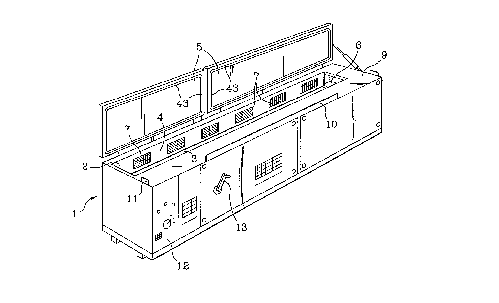Some of the information on this Web page has been provided by external sources. The Government of Canada is not responsible for the accuracy, reliability or currency of the information supplied by external sources. Users wishing to rely upon this information should consult directly with the source of the information. Content provided by external sources is not subject to official languages, privacy and accessibility requirements.
Any discrepancies in the text and image of the Claims and Abstract are due to differing posting times. Text of the Claims and Abstract are posted:
| (12) Patent Application: | (11) CA 2249574 |
|---|---|
| (54) English Title: | DEVICE FOR HEATING PLASTICS PROFILE SECTIONS |
| (54) French Title: | DISPOSITIF POUR CHAUFFER DES PROFILES EN PLASTIQUE |
| Status: | Deemed Abandoned and Beyond the Period of Reinstatement - Pending Response to Notice of Disregarded Communication |
| (51) International Patent Classification (IPC): |
|
|---|---|
| (72) Inventors : |
|
| (73) Owners : |
|
| (71) Applicants : |
|
| (74) Agent: | MARKS & CLERK |
| (74) Associate agent: | |
| (45) Issued: | |
| (86) PCT Filing Date: | 1997-04-30 |
| (87) Open to Public Inspection: | 1997-11-13 |
| Availability of licence: | N/A |
| Dedicated to the Public: | N/A |
| (25) Language of filing: | English |
| Patent Cooperation Treaty (PCT): | Yes |
|---|---|
| (86) PCT Filing Number: | PCT/AT1997/000084 |
| (87) International Publication Number: | AT1997000084 |
| (85) National Entry: | 1998-09-21 |
| (30) Application Priority Data: | ||||||
|---|---|---|---|---|---|---|
|
The invention concerns a device for heating plastics profile sections, in
particular for heating PVC profile sections (35), the device comprising a box
for holding the profile section. Said box has a support plate (3), side panels
and a lid, as well as means for feeding hot air to one end face of the profile
section (35) so that it can flow internally and externally past the profile
section. Efficient operation is attained in that a return duct (21, 22, 23) is
provided for returning and reheating the air when it has flowed through or
around the profile section (35) in order to form a closed air circuit.
L'invention concerne un dispositif permettant de chauffer des profilés en plastique, notamment des profilés (35) en PVC, qui comprend une caisse destinée à contenir les profilés et comportant une plaque d'appui (3), des parois latérales et un couvercle. Ce dispositif comprend également des éléments servant à acheminer de l'air chaud sur une face du profilé (35) et de le faire circuler à l'intérieur et à l'extérieur du profilé. On parvient à un mode opératoire efficace du fait qu'il est prévu une gaine de reprise (21, 22, 23) pour faire revenir l'air et le chauffer à nouveau, après son passage à travers ou autour du profilé (35), afin de former un circuit d'air fermé.
Note: Claims are shown in the official language in which they were submitted.
Note: Descriptions are shown in the official language in which they were submitted.

2024-08-01:As part of the Next Generation Patents (NGP) transition, the Canadian Patents Database (CPD) now contains a more detailed Event History, which replicates the Event Log of our new back-office solution.
Please note that "Inactive:" events refers to events no longer in use in our new back-office solution.
For a clearer understanding of the status of the application/patent presented on this page, the site Disclaimer , as well as the definitions for Patent , Event History , Maintenance Fee and Payment History should be consulted.
| Description | Date |
|---|---|
| Inactive: IPC from MCD | 2006-03-12 |
| Inactive: IPC from MCD | 2006-03-12 |
| Time Limit for Reversal Expired | 2002-04-30 |
| Application Not Reinstated by Deadline | 2002-04-30 |
| Deemed Abandoned - Failure to Respond to Maintenance Fee Notice | 2001-04-30 |
| Inactive: Notice - National entry - No RFE | 1999-10-18 |
| Inactive: Applicant deleted | 1999-10-18 |
| Inactive: Filing certificate correction | 1999-06-28 |
| Letter Sent | 1999-06-23 |
| Inactive: Single transfer | 1999-05-20 |
| Inactive: Notice - National entry - No RFE | 1999-01-13 |
| Inactive: Applicant deleted | 1999-01-13 |
| Inactive: Filing certificate correction | 1998-12-16 |
| Classification Modified | 1998-12-08 |
| Inactive: First IPC assigned | 1998-12-08 |
| Inactive: IPC assigned | 1998-12-08 |
| Inactive: IPC assigned | 1998-12-08 |
| Inactive: Courtesy letter - Evidence | 1998-11-24 |
| Inactive: Notice - National entry - No RFE | 1998-11-19 |
| Application Received - PCT | 1998-11-16 |
| Application Published (Open to Public Inspection) | 1997-11-13 |
| Abandonment Date | Reason | Reinstatement Date |
|---|---|---|
| 2001-04-30 |
The last payment was received on 2000-03-31
Note : If the full payment has not been received on or before the date indicated, a further fee may be required which may be one of the following
Patent fees are adjusted on the 1st of January every year. The amounts above are the current amounts if received by December 31 of the current year.
Please refer to the CIPO
Patent Fees
web page to see all current fee amounts.
| Fee Type | Anniversary Year | Due Date | Paid Date |
|---|---|---|---|
| Basic national fee - small | 1998-09-21 | ||
| MF (application, 2nd anniv.) - small | 02 | 1999-04-30 | 1999-04-15 |
| Registration of a document | 1999-05-20 | ||
| MF (application, 3rd anniv.) - small | 03 | 2000-05-01 | 2000-03-31 |
Note: Records showing the ownership history in alphabetical order.
| Current Owners on Record |
|---|
| TECHNOPLAST KUNSTSTOFFTECHNIK GMBH |
| Past Owners on Record |
|---|
| PIERRE HUGUET |